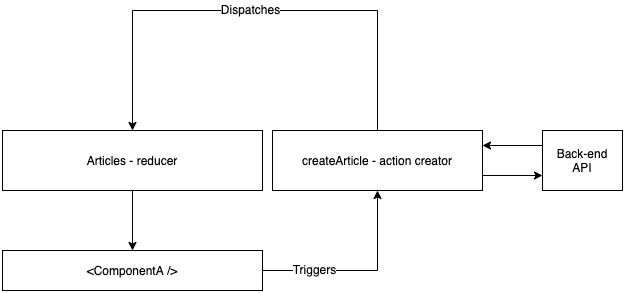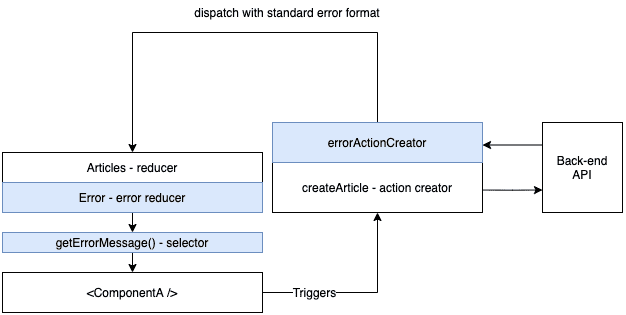A sane approach to error handling with react and redux
7 min read - 2020-04-06
Error handling is a hard subject. It is also not fun, you just don’t wanna do it. At the same time you know it is crucial for good user experience. You can try to forget about them, and use common excuses like “this is not very likely to fail”, “errors will not happen”. Or a more bold, cowboy style phrase like “my code has no bugs” 🤠.
Let me remind you of Murphy’s law:
Anything that can go wrong will go wrong
Trust me, and trust Murphy, it will go wrong. Worse experience than having errors happening is having your user being completely unaware of them and thus not able to react or report.
Error codes format
Pretty much all applications that are bigger than a simple exercise need to deal with errors. If you have an application that does HTTP requests, you know you will end up having to store your HTTP errors somewhere to show them to the user.
We will focus on the strategy we believe to be good to deal and communicate errors to the user.
The first thing we did was to align with the back-end an error format, we ended up with this.
{
"errorCode": "1001",
"errorMessage": "Validation error has occurred.",
"errors": {
"description": "Must not be null",
"name": "Must not be null"
},
"errorTimestamp": "2020-03-06T08:14:03.690Z"
}errorCode is an internal error code the user can use to report the specific error
errorMessage describes the error and is shown to the user, it will later become an i18n code.
errors is an object that describes the errors on the payload that was sent before
errorTimestamp is the timestamp of this response
Integrating errors in reducers and components
As we said before, error handling is not fun. We want to make it as simple as possible so we’re sure the error coverage is easy to increase across the application.
To provide this, we decided to go to a composable solution that can be used in reducers, action creators, and selectors.
If you’re not familiar with redux terms, here’s a TLDR (feel free to skip if you are):
- reducers define how your state is mutated. Based on an action (think an event) and on the current state, they know how to calculate the next state.
- action is similar to an event that is sent to the store to trigger a state change
- action creators are functions that create actions
- selectors are no more than getters to a store, enabling decoupling of the store from its users
The examples we’ve used are written in react, redux and reselect, but the practices and principles used are technology agnostic.
Before - the default way
Let’s create an HTTP request and write the error handling approach.
We will use redux-thunk as we believe they’re simpler to understand. If you’re not familiar with them: they are functions that produce side-effects and dispatch actions.
This is a default thunk, dispatching actions at the start of the request, on success and error.
import axios from "axios"
const createArticle = (title, text) => dispatch => {
dispatch({ type: "CREATE_ARTICLE_REQUEST" })
return axios
.post("/api/articles", { title, text })
.then(successHandler)
.catch(error => {
// Deal with the error
dispatch({ type: "CREATE_ARTICLE_ERROR", error })
})
}Then, in the reducer, the handling would be something like:
const reducer = (state, action) => {
switch (action.type) {
case "CREATE_ARTICLE_REQUEST":
return {
...state,
isLoading: true,
error: null, // reseting the error
}
case "CREATE_ARTICLE_ERROR":
return {
...state,
error: action.error, // setting the error
}
}
}And on your components, you would do something like the following to show the error to the user:
import { useSelector } from "react-redux"
const ArticleListPage = () => {
const errorMessage = useSelector(state => state.articles.error.errorMessage)
return (
<div>
{errorMessage && <p>There was an error: {errorMessage}</p>}
{/* Cut for brevity */}
</div>
)
}We have identified some problems with this approach:
- There is no enforced error structure. One developer can send
errorin the action where others can directly senderror.errorMessage - The code to handle errors on reducers will be repeated for every request and can end up not respecting the structure too.
- If the reducer, action creator or component change, it is very likely that the other 2 will break, they are coupled.
Can't access property 'errorMessage of undefinedI’m looking at you. - Error messages are shown in different formats across the application leading to a not so pleasant user experience.
After - How to solve these problems?
Let’s have a look at the code again:
import axios from 'axios;
const createArticle = (title, text) => dispatch => {
dispatch({ type: "CREATE_ARTICLE_REQUEST" })
return axios
.post("/api/articles", { title, text })
.then(successHandler)
.catch(error => {
// Deal with the error
dispatch(errorActionCreator("CREATE_ARTICLE_ERROR", error))
})
}errorActionCreator implementation that respects FSA
export const errorActionCreator = (errorType, error) => {
return {
type: errorType,
error: true,
payload: error,
}
}Then, in the reducer, the handling would be something like:
const reducer = (state, action) => {
switch (action.type) {
case "CREATE_ARTICLE_REQUEST":
return {
...errorReducer(state, action),
isLoading: true,
}
case "CREATE_ARTICLE_ERROR":
return {
...errorReducer(state, action),
isLoading: false,
}
}
}errorReducer implementation
export const errorReducer = (state, action) => {
if (!action.error) {
return {
...state,
error: null,
}
}
return {
...state,
error: {
errorMessage: DEFAULT_ERROR_MESSAGE,
...action.payload.response.data,
},
}
}And on your components, you would do something like the following to show the error to the user:
import { useSelector } from 'react-redux';
import { getArticlesErrorMessage } from '../store/articles/selectors';
const ArticleListPage = ({ errorMessage }) => {
const errorMessage = useSelector(getArticlesErrorMessage)
return (
<div>
<ErrorMessage message={errorMessage}>
{/* Cut for brevity */}
</div>
);
};Using ErrorMessage component to present the error coherently.
export const ErrorMessage = ({ error }) => {
if (!error) {
return null;
}
return (<p>{error}</p>);
}To finish, we added this selector that is used by components to get error messages.
const getArticlesErrorMessage = createErrorSelector(state => state.articles)The implementation of createErrorSelector is shown below, it extends reselect createSelector to lookup for the error in the specific structure we want.
import { createSelector } from "reselect"
import { get } from "lodash"
export const createErrorSelector = fn => {
return createSelector(
fn,
storeIndex => get(storeIndex, "error.errorMessage", null)
)
}With this approach, we managed to fix all the listed problems. We have created a layer of decoupling that enables us to change without breaking all the other usages.
- Enforced error structure
- Error reducer is shared
- Decoupled reducers and components from errors format
- Error messages are shown coherently
We’ve decided to locate the 3 functions: createErrorSelector, errorReducer and errorActionCreator in the same file. If one of them needs to be changed, it most likely means that the other two also need to. In contrast, all the reducers, components and thunks that are dealing with errors can remain intact.
This was the kind of flexibility we aimed to.
Side by side
Before
After
In blue are the layers we’ve added.
Future improvements
If we decide to add translation codes or to change the error structure that comes from the back-end, we know we will only have to change a single file.
Writing code that is easy to change is something we’re always aiming for at KI labs and xgeeks. Our habitats are fast-changing environments and recently bootstrapped companies that iterate fast. Reach out to us if this is an environment where you would thrive into! 😉
How are you handling your errors in this kind of situation? Have you created something similar? Are you using something automated to deal with error states? How are you displaying them?
I’d love to hear if this solution fixes some of your problems, and if it doesn’t, why?
Reach me out via email or twitter
Thanks for reading 🙌

